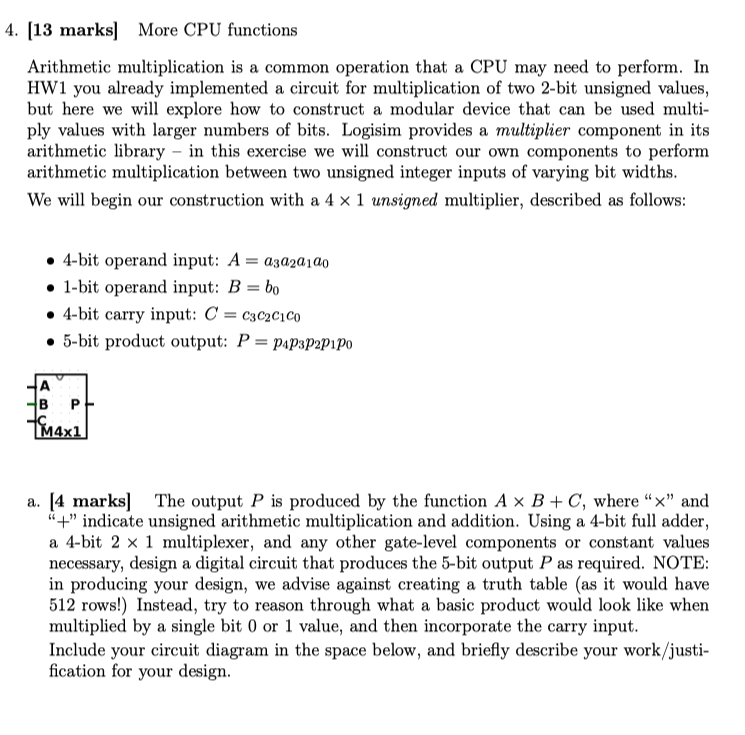
4. [13 marks] More CPU functions Arithmetic multiplication is a common operation that a CPU may need to perform. In HW1 you already implemented a circuit for multiplication of two 2-bit unsigned values, but here we will explore how to construct a modular device that can be used multi- ply values with larger numbers of bits. Logisim provides a multiplier component in its arithmetic library in this exercise we will construct our own components to perform arithmetic multiplication between two unsigned integer inputs of varying bit widths. We will begin our construction with a 4 x 1 unsigned multiplier, described as follows: 4-bit operand input: A = 23220120 1-bit operand input: B = bo . 4-bit carry input: C = 23C2C.Co 5-bit product output: P = pap3p2pipo A TM4x1 a. [4 marks] The output P is produced by the function A x B + C, where "X" and "+" indicate unsigned arithmetic multiplication and addition. Using a 4-bit full adder, a 4-bit 2 x 1 multiplexer, and any other gate-level components or constant values necessary, design a digital circuit that produces the 5-bit output P as required. NOTE: in producing your design, we advise against creating a truth table (as it would have 512 rows!) Instead, try to reason through what a basic product would look like when multiplied by a single bit 0 or 1 value, and then incorporate the carry input. Include your circuit diagram in the space below, and briefly describe your work/justi- fication for your design. 4. [13 marks] More CPU functions Arithmetic multiplication is a common operation that a CPU may need to perform. In HW1 you already implemented a circuit for multiplication of two 2-bit unsigned values, but here we will explore how to construct a modular device that can be used multi- ply values with larger numbers of bits. Logisim provides a multiplier component in its arithmetic library in this exercise we will construct our own components to perform arithmetic multiplication between two unsigned integer inputs of varying bit widths. We will begin our construction with a 4 x 1 unsigned multiplier, described as follows: 4-bit operand input: A = 23220120 1-bit operand input: B = bo . 4-bit carry input: C = 23C2C.Co 5-bit product output: P = pap3p2pipo A TM4x1 a. [4 marks] The output P is produced by the function A x B + C, where "X" and "+" indicate unsigned arithmetic multiplication and addition. Using a 4-bit full adder, a 4-bit 2 x 1 multiplexer, and any other gate-level components or constant values necessary, design a digital circuit that produces the 5-bit output P as required. NOTE: in producing your design, we advise against creating a truth table (as it would have 512 rows!) Instead, try to reason through what a basic product would look like when multiplied by a single bit 0 or 1 value, and then incorporate the carry input. Include your circuit diagram in the space below, and briefly describe your work/justi- fication for your design







